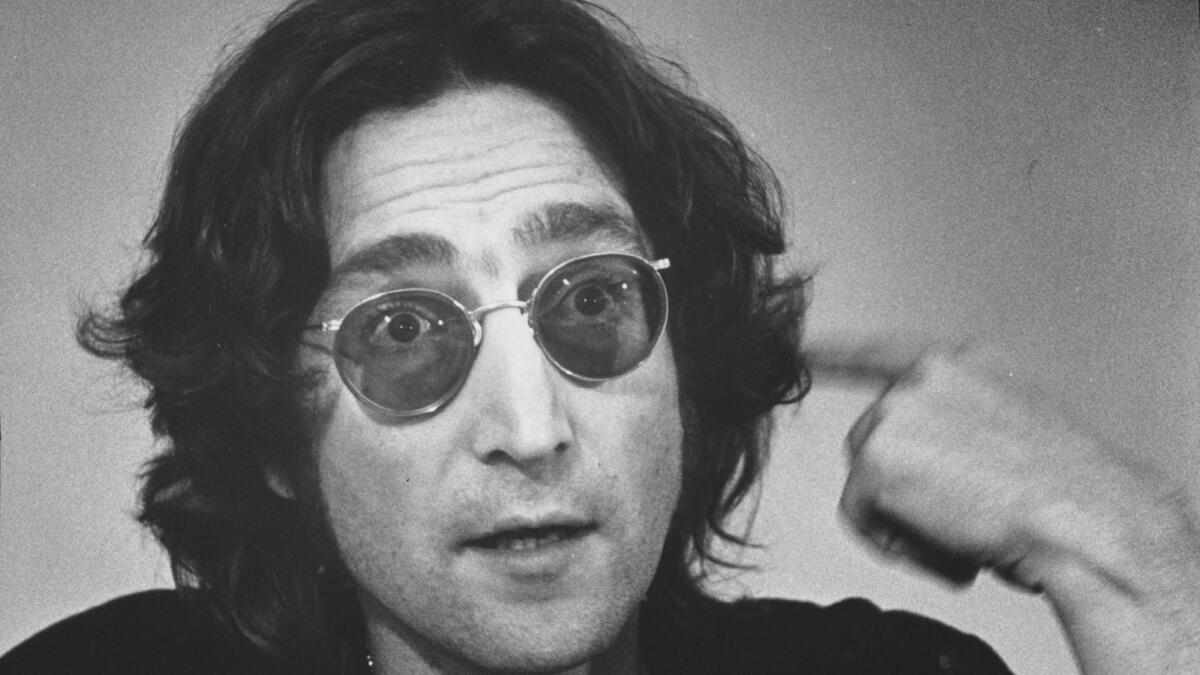From the Archives: With ‘Imagine,’ John Lennon continues his use of music to express his deepest feelings

- Share via
Editor’s note: In honor of the 45th anniversary of John Lennon’s second solo album, “Imagine,” which was released in the U.S. on Sept. 9, 1971, read The Times’ original review of the album:
Not only does John Lennon’s new “Imagine” solo album give him a 2-0 lead over Paul McCartney in the post-Beatles competition, but it contains a song that apparently reflects just how bitter the differences between the onetime songwriting team remain.
In “How Do You Sleep,” Lennon doesn’t mention McCartney by name but there seems little question about the target of his remarks when he sings:
“Those freaks were right when they said you was dead/The one mistake you made was in your head.”
Later in the song Lennon adds:
“The only thing you done was yesterday/And since you’re gone, you’re just another day.”
And:
“A pretty face may last a year or two/but pretty soon they’ll see what you can do./The sound you make is Muzak to my ears/You must have learned something in all of those years.”
The references, of course, seem obvious: There was the rumor a couple of years ago about McCartney being dead; one of McCartney’s most popular compositions with the Beatles was “Yesterday,” while one of the songs he has written since leaving the group is “Another Day”; McCartney was always considered the cutest (or prettiest) of the Beatles, and many feel his music these days in undistinguished (i.e., like background Muzak).
The personal nature of “Sleep” underscores Lennon’s continued use of music to express (some may say vent) his deepest feelings. It began in this first solo album last year and is very much in evidence in the new LP record which goes on sale next week.
For me, Lennon’s first album was the best of 1970 and “Imagine” is such a strong, flavorful, intriguing follow-up that it’s certain to be a leading contender for that same title this year. It’s an extraordinary album in both emotional and musical range, adding even more to Lennon’s already enormous stature in pop music.
It is quite probable “Imagine” will be even more popular than its predecessor because its more active instrumentation (some felt the music was too sparing in the 1970 album) and varied themes (from hard-core rock ‘n’ roll to sociopolitical comment to some soft, reflective moments of matters of love) make it more easily accessible for most listeners.
Produced by Lennon, Yoko Ono and Phil Spector, the album was recorded in England with string section later added in New York. Among the numerous musicians featured on the album: George Harrison, Ringo Starr and Klaus Voorman, the bass player whose name is always mentioned as a substitute in any possible neo-Beatles lineup.
Among the album’s highlights:
“Imagine” — In the hands of many, this song about peace in the world would end up a lifeless collection for sociopolitical cliches, but Lennon’s deft arrangement and delicate vocal overcome these inherent dangers as he sings: “Imagine there’s no countries… nothing to kill or die for… you may say I’m a dreamer/But I’m not the only one/I hope someday you’ll join us And the world will be one.”
“Crippled Inside” — The best Beatles-associated rock ‘n’ roll tune since “The Ballad of John and Yoko” nearly two years ago. An irresistible instrumentation carries such a vintage rockabilly flavor that it could have been recorded in the old Sun studios in Memphis.
The song has the classic Lennon/Beatles touch of humor and stinging truth combined: “You can shine your shoes and wear your suit/You can hide your face behind a smile (but) one thing you can’t hide is when you’re crippled inside.”
“Give Me Some Truth” — Similar in tone to the outrage and frustration in “Working Class Hero” and “I Found Out” on the first Lennon solo album. Here, there’s a great sense of anger and impatience in Lennon’s voice as he shouts: “I’m sick to death of hearing things from uptight, short-sighted, narrow-minded hypocrites./All I want is the truth now./Just give me some truth now.” There’s a growing, a gripping tension in the instrumentation that adds greatly to the total impact.
“How” — Another song that easily could have fit the “personalized diary” mood of Lennon’s 1970 album. It expresses the difficulty in such fundamental human areas as loving, feeling and believing. “How can I go forward when I don’t know which way I’m giving...” Fine, controlled, sensitive vocal with with appropriately slender background instrumentation.
“How Do You Sleep” — The song with the McCartney references. As with “Give Me Some Truth,” there’s a driving intensity to the background that matches perfectly the tenor of the theme.
“Oh Yoko” — A happy (at last), joyful song from Lennon in celebration of love: “In the middle of the night. I call your name…” Since there has unfortunately been so much resentment directed at Yoko in the last few years, it would have been safer from a commercial standpoint for Lennon to change the name of the girl in the song, but, after all, she’s the one it’s all about and it tells a lot about Lennon that he didn’t change the name.
When the Beatles broke up, many people wondered whether McCartney or Lennon would do the best work. But the fact that “Imagine” is so much more satisfying that McCartney’s “Ram” seems less the point that that Lennon has established himself in this album and his first as — even without considering his work with the Beatles — an artist of the highest level.
More to Read
The biggest entertainment stories
Get our big stories about Hollywood, film, television, music, arts, culture and more right in your inbox as soon as they publish.
You may occasionally receive promotional content from the Los Angeles Times.








